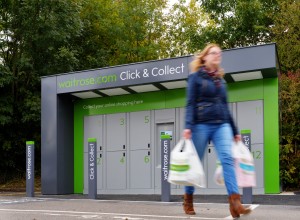The shining technology stars of 2014

Image courtesy of Waitrose
2014 has seen another eventful year for technology in the retail and hospitality space.
Digital delights have included the: beacon, interactive mirror, pre-order app, interactive table, concierge app, QR code, slim line check out, click and collect, digital receipts, mobile EPoS, and most recently wearable technology and 3D and augmented reality.
Each has shared a moment in the spotlight vying for the retailer’s attention in order to please and serve their customers more effectively. For some of these technologies, it’s been a pleasant surprise to see them still holding their place on the sliding scale of what is in demand by consumers and business. While others have truly shined and shown themselves to be valuable to both parties, and a few are really just finding their feet and more likely to see bigger things in 2015.
As we gear up for a new year of retail and hospitality technology developments to come in 2015, we take a look at the highlights of 2014:
The shining technology stars of 2014
Mobile EPoS
Whether it’s used for offering customers access to product information, helping staff to take payment at any place in store or more, the tablet has provided many an opportunity for mobile electronic point of sale this year.
- Portable tablets were a part of Carphone Warehouse’s digital concept phone store where they were used as a sales tool to help store assistants guide the customer through the right phone and tariff for them.
- Monsoon Accessorize, fashion retailer, made great use of iPads in store to show customers the store’s full product range, to locate stock, and to complete a sale.
- Shoe retailer, Clarks, made use of an iPad as a foot-measuring tool in its children’s department that digitally measured a child’s foot and then built a customised shoe guide.
- Restaurant chain, YO! Sushi, opted for a mobile payment solution that let waiting staff take and track orders, and also raise bills on the spot.
- Many retailers have also taken advantage of mobile EPoS’ portable nature and used them to create product interest and take payment at short-term events and in pop-up stores.
- On a customer-facing note, mobile technology was used by grocer Sainsbury’s for a mobile scan & go service. The customer could scan their shopping on their smartphone, pack as they shopped and keep a running total of how much they’ve spent. When they finished shopping, they could choose to pay on their mobile or at a self check out.
Click and collect
This convenient service has really taken off this year for its ability to provide customers with an easy shopping method of buying online and collecting on their way home whether it be from the store, another store or at a transport station.
- Asda was the first of the grocer retailers to spot the potential of the London underground as a pick up point, with other retailers such as Tesco and Waitrose quickly following suit, while some fashion stores tested the likes of railway stations (Asos and New Look).
- Waitrose supermarket also introduced automated, temperature-controlled, grocery Click & Collect lockers across the transport network so that its customers could order chilled and frozen food without worrying about timings.
- Meanwhile a joint venture was also born between department store House of Fraser and café Caffe Nero that opted to offer coffee downstairs and a click and a collect service upstairs. Downstairs, in Caffe Nero several tablet and touch screen devices allowed guests to shop online. While upstairs in House of Fraser, customers could pay for and order items and try things on.
Pre-order app
There have been a few variations of the pre-order app this year used particularly coffee shops and fast-food chains that turn around products quickly, for customers that are generally on-the-go and therefore rely on speedy service.
- Fast food chain KFC, for example introduced the My KFC app which could fast track a customer’s order by enabling them to order in advance, pay by credit or debit card or Pay Pal, and then collect their food quickly on arrival.
- Coffee specialist Harris+Hoole had a different style of mobile app that the customers added funds to and then used to place their order on arrival in the shop. The app took the order and payment and then sent the order to the barista along with the customer’s name and photo to personalise the collection experience.
- Meanwhile in addition to having a payment app to speed up transactions, Starbucks coffee shop also helped it customers to find its nearest shop, then while they were waiting in line to be served it entertained them with access to free music video downloads from iTunes.
Concierge app
A number of hotel providers adopted the mobile app this year as a means of enhancing the customer experience before, during and after their stay, by giving hotel guests a more personalised and local experience.
- Marriott hotel for example opted for mobile check-in and check-out services with plans to introduce service requests, while Hilton hotel has gone one step further and is offering room selection as well.
- What’s more, an app from Delta Hotels and Resorts really suggests where hoteliers should be looking to go with this technology. Its app provided the opportunity for guests to order breakfast, lunch and dinner, make in room and service requests and express check-out, plus receive local information, such as weather, seasonal events and tourist attractions.
- Not to mention hotel operator, Accor, that in 2015 also plans to take mobile apps into the guest’s hotel room and bypass the front desk by offering mobile key entry.


No comments yet.